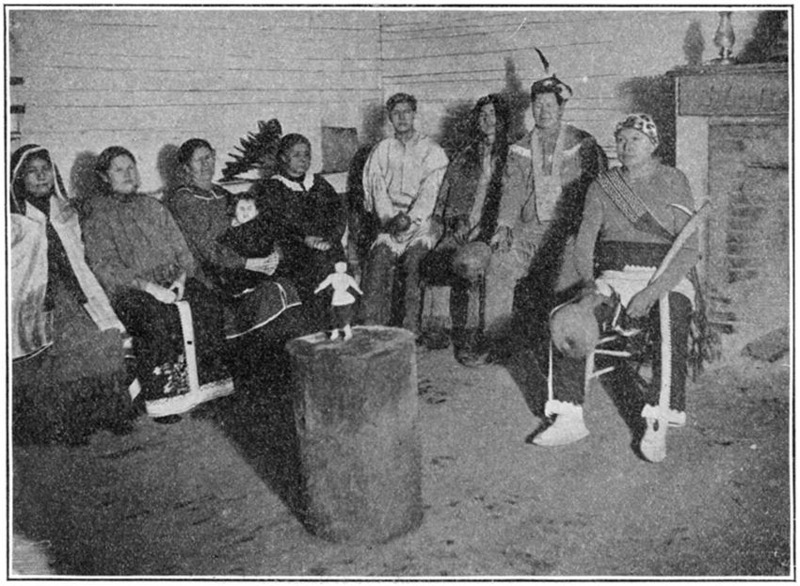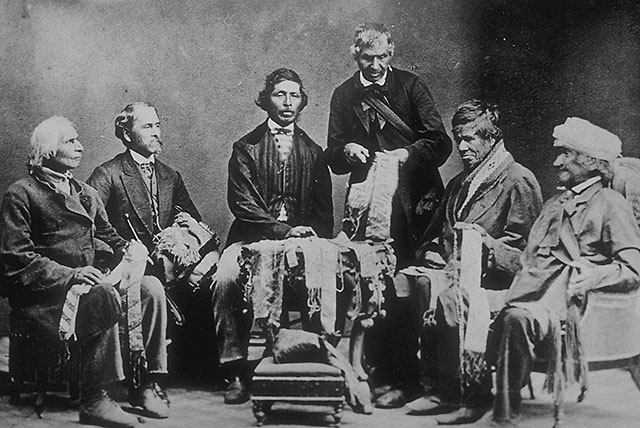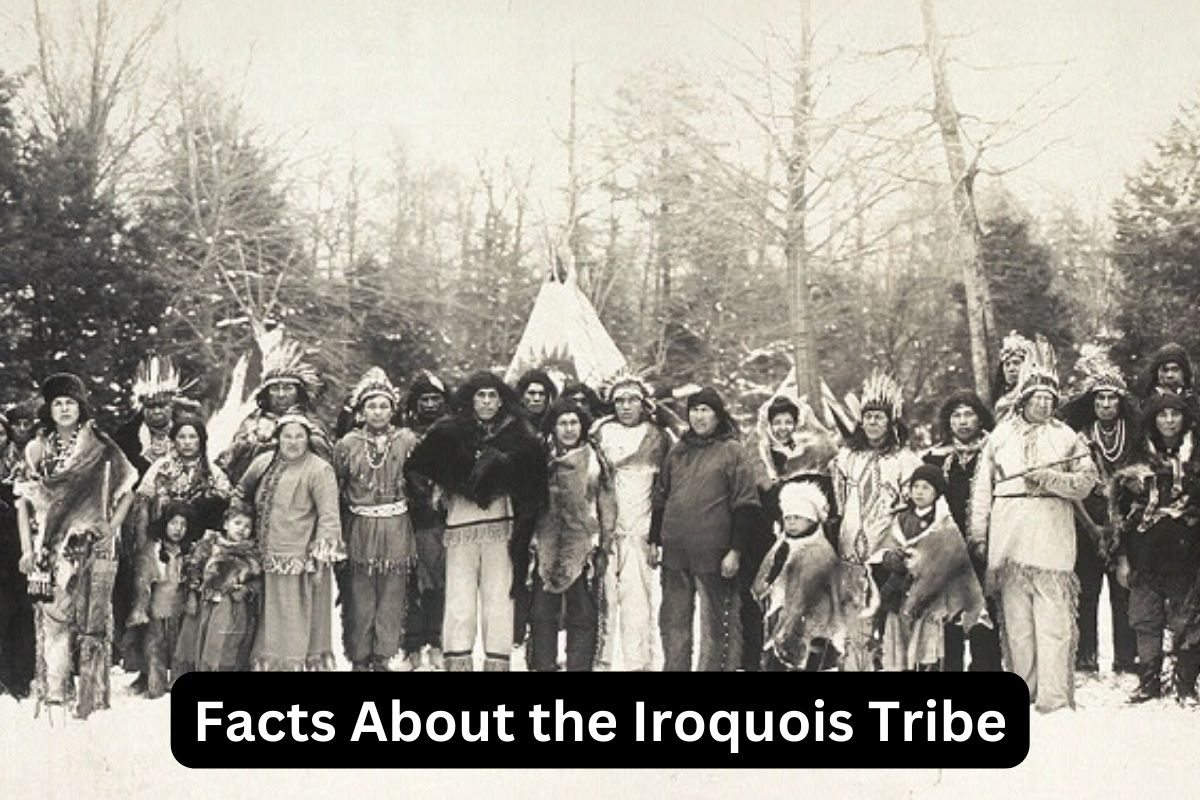The Iroquois, also known as the Haudenosaunee, are a confederacy of Native American tribes located in the northeastern United States and southeastern Canada. Comprising the Mohawk, Oneida, Onondaga, Cayuga, Seneca, and later joined by the Tuscarora, the Iroquois Confederacy is one of the oldest democracies in the world.
Founded in the late 1500s or early 1600s, the Iroquois developed a system of governance based on collective decision-making and consensus-building. They were skilled agriculturalists, cultivating crops like corn, beans, and squash using the sustainable “Iroquois method.”
The Iroquois lived in longhouses and maintained a matrilineal society, where women played significant roles in decision-making and clan membership was crucial.
Known for their hunting, fishing, and gathering practices, the Iroquois also participated in the fur trade with European settlers, which had a significant impact on their way of life.
Iroquois Tribe Facts
1. The Iroquois are a confederacy of Native American tribes located in the northeastern United States and southeastern Canada
The Iroquois, also known as the Haudenosaunee, are a confederacy of Native American tribes located in the northeastern United States and southeastern Canada.
The confederacy is composed of five tribes:
- The Mohawk
- Oneida
- Onondaga
- Cayuga
- Seneca.
The Tuscarora joined the confederacy later in the 18th century after migrating from the Carolinas. Each tribe maintained its own distinct language, culture, and territory, but they came together under the principles of the confederacy for mutual benefit and protection.

2. The Iroquois Confederacy was founded around the late 1500s or early 1600s
The Iroquois Confederacy was founded around the late 1500s or early 1600s. The exact date is uncertain due to limited written records, but oral tradition and archaeological evidence suggest its establishment during this period.
Also Read: Facts About the Cheyenne Tribe
The confederacy was formed as a response to external threats and conflicts between the member tribes. The Great Law of Peace, a set of guiding principles and laws, was established to govern the confederacy and maintain unity among the tribes.
This system of governance was characterized by a participatory democracy, where decisions were made through discussion, consensus-building, and representation from each tribe.
3. The Iroquois were skilled agriculturalists, growing crops such as corn, beans, and squash, which were known as the “Three Sisters”
The Iroquois were skilled agriculturalists. They cultivated several staple crops, the most important being the “Three Sisters” – corn, beans, and squash. This agricultural system, also known as the “Iroquois method” or “Three Sisters agriculture,” involved interplanting the three crops in a symbiotic manner.
Also Read: Apache Tribe Facts
Corn provided stalks for the beans to climb, beans enriched the soil with nitrogen, and squash leaves shaded the ground, reducing weed growth and moisture loss. This interdependence maximized yields and ensured a sustainable and balanced agricultural system.
In addition to the Three Sisters, the Iroquois also grew other crops such as tobacco, sunflowers, and various root vegetables. Agriculture played a crucial role in their subsistence, providing them with a stable food source and enabling sedentary settlements.
4. The Iroquois lived in longhouses, which were large, communal dwellings that housed extended families
The Iroquois lived in longhouses, which were distinctive and practical communal dwellings. These longhouses were typically made of wooden frames covered with bark or mats. They were long and narrow, often measuring around 60 to 100 feet in length and 20 feet wide.
The structure consisted of a series of compartments, each housing one or more families. A central corridor ran the length of the longhouse, with individual family spaces opening onto it.
The extended family members lived together in these longhouses, fostering close-knit relationships and a sense of community. Each longhouse was usually home to several generations of a matrilineal clan, with multiple families sharing the common space.

5. The Iroquois were known for their matrilineal society
The Iroquois had a matrilineal society, where kinship and lineage were traced through the mother’s line. In this system, children belonged to their mother’s clan, and clan membership was a fundamental aspect of their identity.
The clans were matrilineal and exogamous, meaning that individuals had to marry someone from a different clan. Clan membership determined social roles, responsibilities, and interactions within the community.
Women held significant positions of power within the society, including selecting and removing leaders. The clan mothers, who were often older women respected for their wisdom, had important responsibilities in decision-making processes and played a crucial role in maintaining social harmony.
6. The Iroquois had a matrilineal kinship system, meaning that children belonged to their mother’s clan
The Iroquois had a complex kinship system that went beyond the immediate family structure. They recognized both patrilineal and matrilineal ties and maintained a balance between them. In addition to the matrilineal clan, which determined their social and familial connections, they also had patrilineal clans called sachems.
The sachems were responsible for selecting and appointing leaders within the tribe. These leaders were typically men and held positions such as chiefs and sachems.
The Iroquois kinship system allowed for a balance of power and representation between both genders and ensured a well-rounded governance structure within the confederacy. It also facilitated social connections and alliances with other tribes through intermarriage and kinship networks.
7. The Iroquois were skilled hunters, relying on game such as deer and beaver for food, clothing, and tools
The Iroquois were skilled hunters and relied on hunting as an important source of food, clothing, and tools. They were adept at tracking and trapping game such as deer, moose, bear, and small mammals.
Hunting was often a communal activity, with individuals working together to ensure a successful hunt. They used various techniques and tools, including bows and arrows, spears, snares, and traps.
The animals they hunted provided meat for consumption, hides for clothing and shelter, bones for tools and implements, and other valuable resources that were essential to their way of life.
8. The Iroquois had a complex political structure
The Iroquois had a complex political structure that was instrumental in the functioning of their confederacy. At the core of their political system was a decentralized form of governance that balanced power between the individual tribes and the confederacy as a whole.
Each tribe within the Iroquois Confederacy had its own council, consisting of representatives from different clans and families. These councils made decisions regarding internal affairs and issues specific to their respective tribes. The decisions made at the tribal level were important for maintaining autonomy and addressing local concerns.
On a larger scale, representatives from each tribe came together in a Grand Council, also known as the Great Council or the Grand Council of Sachems.
This council was responsible for making decisions that affected the entire confederacy, such as matters of war, peace, trade, and external relations. The Grand Council was composed of sachems, who were appointed by the clan mothers and held influential positions within their respective tribes.
9. The Iroquois had a rich oral tradition and storytelling was an integral part of their culture
The Iroquois had a vibrant and rich oral tradition, with storytelling occupying a central place in their cultural practices. Storytelling served as a means of passing down history, traditions, myths, legends, and moral lessons from one generation to the next.
Storytellers, often respected elders or individuals with a deep understanding of the tribe’s narratives, played a crucial role in preserving and transmitting the collective wisdom and knowledge of the Iroquois.
They would gather the community around them, whether in informal gatherings or formal occasions, and captivate their listeners with tales that spanned generations.
10. The Iroquois were known for their participation in the fur trade with European settlers
The Iroquois actively participated in the fur trade with European settlers. They had access to valuable fur-bearing animals such as beavers, otters, foxes, and minks in their territories. European traders, particularly the French and Dutch, sought these furs for the European fashion market.
The Iroquois began trading furs with the Europeans in the early 17th century, exchanging them for metal tools, firearms, textiles, and other European goods. The fur trade brought about changes in their economy, social structure, and relationships with European powers.
It influenced their hunting practices, as they began to focus more on trapping beavers for their pelts. The fur trade also led to the formation of alliances and conflicts between the Iroquois and various European factions, as they strategically aligned themselves to maximize their trade advantages.
